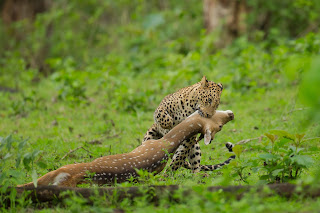Leopard – The Ambush hunter!
It is rightly said and I believe it too – wild animals make
their appearance or create a natural history when you least expect it. This was
one such day at Kabini, (Nagarahole) during monsoons (June 2016). I personally
believe that monsoons are the best time to visit forests simply for its
soothing greenery and as a wildlife photographer one can make amazing images
with lovely colors. However the flip side of this is the animal viewing can
also be very low due to thick vegetation.
 And indeed it was a
dry morning safari drive for the first hour or more and then as matter of luck
a leopard was spotted relaxing on a bund on a popular location known as
president road at Kabini. I was busy making portraits of this young male
leopard; little did I expect, that a storm was all set to break. Refer (Image
1)
And indeed it was a
dry morning safari drive for the first hour or more and then as matter of luck
a leopard was spotted relaxing on a bund on a popular location known as
president road at Kabini. I was busy making portraits of this young male
leopard; little did I expect, that a storm was all set to break. Refer (Image
1)
It was just about 8am and suddenly dark clouds were seen
covering the sky, a storm was surely on its way. In the meantime the leopard decided
to move and took cover inside the bushes. He had noticed that a large group of
spotted deers (Chital) approaching in his direction. I looked at the deers they
were over 50mts away, and completely unaware of the leopard’s presence.
Excitement began, I anticipated some action, and I kept my
eye towards the bushes and the deers. The leopard patiently waited, stalked and
finally the storm broke. The leopard popped out in a flash, putting his special
technique on job, Precision, Speed and Power, he attacked one of the deers,
didn’t even give a chance for it to react. Typically the leopard’s strength and
strategy is to strangle her to death by choking her windpipe. And this is what
exactly we witnessed, holding the prey by throat. The alarm calls given by
large group of deers are still echoing in my ears. (Refer Image 2)
Initially the leopard tried dragging the deers utilizing the
strength of his jaws and moving backwards, he realized it was taking longer
than expected, as the deer was quite heavy. These cats avoid exposing their
kill in the open for various reasons, like counter attack by other predators or
scavengers hence will make all possible efforts to drag the prey into the
bushes and later carry it high up on a tree.
The leopard continued to drag the chital, taking breaks in
intervals of few seconds and it was interesting to observe the leopard taking
cover under this small fallen branch of a tree surrounded with bunch of leaves.
Infact these cats will make every possible attempt to avoid and expose them in
the open,. (Refer image 3)
To ensure he moves quickly the typical strategy adopted by
the leopard, he actually brings down the chital under his belly between the
hind legs, yet holding it firmly with his jaws and walks fast and disappears
into the bushes. (Refer image 4).
The action was not over yet, probably the Rain Gods too held
their excitement during this hunt and suddenly clouds broke and it poured cats
and dogs. I felt truly blessed to witness this fine and rare natural history,
however one of my friends couldn’t control her emotions and tears were seen
pouring from her eyes. This is the truth of raw nature; in order for one to
live other has to die, that’s how life in our Forest Ecosystem is continues…
More information on Leopards -
Leopards use a combination of stealth and patience when
hunting, moving in as close as possible to the prey before attempting a charge
or lying in wait for the prey to come within range. The power of the leopard
enables it to pull the carcass onto a tree away from other predators such as
tigers and wild dogs. A leopard can lift 2-3 times more than its own body
weight into the branches.
you may wish to follow me on https://www.facebook.com/PraveenSiddannavarPhotography/
you may wish to follow me on https://www.facebook.com/PraveenSiddannavarPhotography/





















